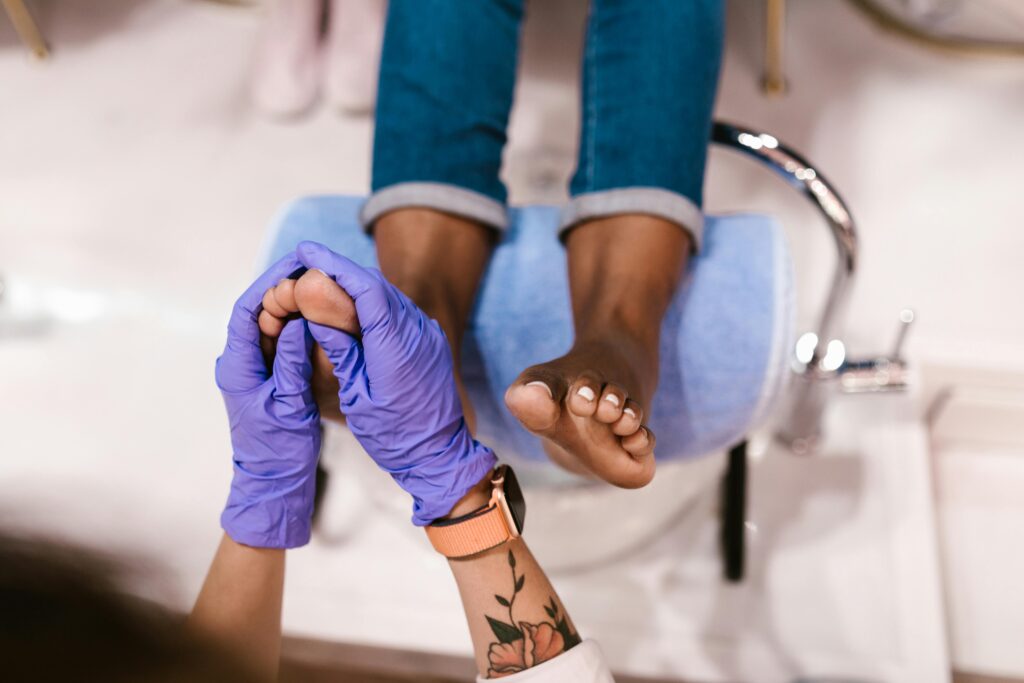Can Poor Foot Care Lead to Financial Ruin?
The price of poor foot care can be disastrous for people with diabetes. Imagine waking up one morning to find a small sore on your foot. It doesn’t seem like much, but this seemingly minor injury could lead to a major financial problem if you have diabetes. That’s because people with diabetes are more prone to foot problems, and these problems can get serious, fast.
500 million people worldwide are diagnosed with diabetes.
It is estimated that 19-34% of these people will develop a foot ulcer in their lifetime.
Diabetes foot care is therefore critical to preventing foot problems.

Table of Contents
Do the horrendous diabetes statistics result from poor foot care?
Existing figures show that there are over 500 million people worldwide diagnosed with diabetes. Even worse, it is estimated that 19-34% of these people will develop a foot ulcer in their lifetime. The stats are not encouraging because approximately 20% (500 million) of individuals with a diabetic foot ulcer will require a lower-extremity amputation.
Can diabetic foot ulcers result from poor foot care?
Why Diabetes and Foot Problems Don’t Mix
Diabetes can damage the nerves in your feet, making it harder to feel pain, heat, or cold. This can lead to injuries that you might not even notice. High blood sugar can also damage the blood vessels in your feet, reducing blood flow and making it harder for wounds to heal.
The Price of Neglect
If a foot wound doesn’t heal properly, it can turn into a serious infection. This infection can spread to your bones and even require amputation. Amputation is a major surgery that can have a huge impact on your life, both physically and financially.
The Financial Toll
The costs of treating diabetic foot problems can be staggering. Hospital stays, surgeries, medications, and physical therapy can quickly add up. And that’s not to mention the lost wages from missing work.
In the USA alone, diabetic foot ulcers place a huge strain on the U.S. healthcare system, costing billions of dollars annually. As stated by the health innovation program from the University of Wisconsin. Diabetic foot ulcers cost the U.S. healthcare system $130 billion annually.
Estimating the cost of diabetic foot ulcers (DFUs) on individuals involves considering both direct medical expenses and indirect costs that impact quality of life.

Cost estimates of diabetic foot ulcers on individuals
Direct Medical Costs:
Treatment:
This includes wound care, antibiotics, hospitalizations, surgeries (including amputations), and specialized footwear.
Costs vary significantly depending on the severity of the ulcer and any complications.
Hospital stays alone can be very expensive. Studies show that the cost of treating a foot ulcer can be very high, and if amputation is needed that cost rises drastically.
Ongoing Care:
Ongoing care includes regular doctor visits, wound dressings, and other supplies contribute to ongoing expenses.
Amputation:
If amputation is necessary, costs skyrocket. This includes the surgery itself, prosthetics, rehabilitation, and long-term care.
Indirect Costs of diabetic foot ulcers:
Lost Income:
DFUs can significantly impact a person’s ability to work, leading to lost wages.
Long-term disability may result in a permanent loss of income.
Reduced Quality of Life:
Pain, discomfort, and limited mobility can significantly affect a person’s well-being.
Psychological distress, such as depression and anxiety, is also common.11
Caregiver Burden:
Family members may need to provide care, which can lead to lost work hours and emotional strain.
General Cost Estimates:
Research indicates that the cost of treating DFUs can range widely, from several thousand dollars for minor ulcers to tens of thousands of dollars for severe cases requiring amputation.
Studies have shown that individuals with DFUs incur significantly higher healthcare costs compared to those without. Factors such as the presence of infection and the need for hospitalization greatly increase costs.
It is important to understand that the cost to the individual is not only monetary. The loss of mobility, and the emotional stress that accompanies DFU’s is a very large cost to the individual.16
Key Considerations:
Early detection and prevention are crucial for minimizing costs. Proper foot care, regular checkups, and effective diabetes management can help reduce the risk of DFUs.
Access to quality healthcare and specialized wound care is essential for optimal outcomes.
In essence, the financial and personal burden of DFUs on individuals is substantial, highlighting the importance of prevention and effective management.
The Heavy Burden of Diabetic Foot Ulcers
A study by the American Diabetes Association found that the average annual medical cost for individuals with diabetes is $16,752, more than double the cost for those without diabetes. Foot complications can account for a significant portion of these costs.
The Impact on Quality of Life
Beyond the financial burden, diabetic foot problems can also take a toll on your quality of life. Pain, limited mobility, and the emotional stress of dealing with a chronic condition can all impact your overall well-being.
Taking Control of Your Financial Future
The good news is that you can take steps to prevent diabetic foot problems and protect your financial health. Here are some tips:
- Check Your Feet Daily: Look for cuts, blisters, or red spots.
- Wash Your Feet Daily: Use warm water and mild soap.
- Dry Your Feet Thoroughly: Pay special attention to the areas between your toes.
- Moisturize Your Feet: Use a lotion or cream, but avoid putting it between your toes.
- Trim Your Toenails Carefully: Cut them straight across and file the edges.
- Wear Well-Fitting Shoes: Avoid shoes that are too tight or too loose.
- Protect Your Feet from Injury: Wear shoes, even indoors.
- See Your Doctor Regularly: Get regular checkups to monitor your blood sugar and foot health.
Seeking Help and Support
If you’re struggling to afford the costs of diabetic foot care, there are organizations that can help. Many government programs, such as Medicare and Medicaid, cover some or all of the costs of diabetes-related care. You may also be eligible for financial assistance from nonprofit organizations.
Taking Action
By taking proactive steps to manage your diabetes and care for your feet, you can reduce your risk of serious complications and protect your financial future.
Remember, your feet are important. Treat them with care.
National Institute of Diabetes and Digestive and Kidney Diseases.
